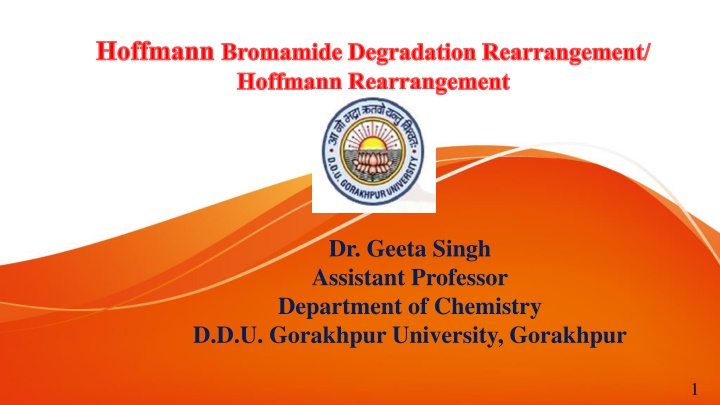
Hoffmann Rearrangement: Mechanism, Evidence, and Stereochemistry
Explore the fascinating Hoffmann Rearrangement, a reaction where amides rearrange to form primary amines. Delve into its mechanism, evidence for intramolecularity, and stereochemistry. Learn about the contributions of August Wilhelm von Hoffmann to organic synthesis.
Download Presentation

Please find below an Image/Link to download the presentation.
The content on the website is provided AS IS for your information and personal use only. It may not be sold, licensed, or shared on other websites without obtaining consent from the author. If you encounter any issues during the download, it is possible that the publisher has removed the file from their server.
You are allowed to download the files provided on this website for personal or commercial use, subject to the condition that they are used lawfully. All files are the property of their respective owners.
The content on the website is provided AS IS for your information and personal use only. It may not be sold, licensed, or shared on other websites without obtaining consent from the author.
E N D
Presentation Transcript
Hoffmann Bromamide Degradation Rearrangement/ Hoffmann Rearrangement Dr. Geeta Singh Assistant Professor Department of Chemistry D.D.U. Gorakhpur University, Gorakhpur 1
CONTENTS History of Hoffmann Hoffmann Rearrangement Mechanism Stereochemistry Rate of Hoffmann Reaction Application 2
Question Discuss Hoffmann rearrangement in light of I. Its Mechanism II. Evidences for Intramolecularity III. Its Stereochemistry
AUGUST WILHELM VON HOFFMANN Born 8th April 1818 Giessen, Germany. Died on 5th May(aged 74) Berlin, Germany Education- University of Gottingen Doctoral Students Adoff Pinner Richard Abegg Fritz Haber Hofmann was a major contributor to the development of techniques for organic synthesis. 3
HOFFMAN REARRANGEMENT Amides when treated with bromine in presence of KOH/NaOH undergo rearrangement to give primary amine is called Hoffmann Rearrangement. Reaction:- 4
MECHANISM The Mechanism has been suggested on the basis of intermediates isolated during the course of reaction. Steps: 1. The base abstract an acidic H of amide yielding an anion 2. The Anion then react with bromine atom to give bromamide 3. The base abstraction of remaining amide proton gives a bromamide anion 4. This bromamide anion undergoes an intramolecular rearrangement as the R group attached to carbonyl carbon migrate to N and Br being a good leaving group leaves to produce an Isocynate 5. Isocynate react with water which spontaneously eliminate Carbon dioxide to yield the product. Note: Only one unit of bromine will be used otherwise in Step 2 bromine will attack on Nitrogen and make compound but we need the anion to make the desired product
Evidence for Intramolecularty Intramolecular nature of the rearrangement has been confirmed by several cross over experiments and no cross product was isolated implies intramolecular reaction. Its clearly indicate that Transition state is formed. When the Hoffmann Rearrangement is carried out with mixture of m-deuteriobenzamide & benzamide (*N15), only m-deuterioaniline & aniline(*N15) are formed. This shows that the rearrangement is intramolecular, if it is intermolecular then the cross -products such as aniline & m-deuterioaniline (*N15) were also formed. 7
Other Evidences All intermediates like N-haloamide, Conjugate base of N-haloamide and Isocynate has been isolated. The formation of Nitrene as intermediate has been ruled out because if Nitene would formed ,it would give Hydroxamic acid as a product which is not obtained in the HR reaction. The formation of Isocynate proves Intramolecularity of reaction. The loss of bromine and migration of alkyl group is suggested to be concerted.
STEREOCHEMISTRY An interesting stereochemical observation is that if the migrating group (R) is chiral, its configuration is retained in the product amine. Thus this rearrangement is Intramolecular , the migrating group does not become free, but remains attached with the substrate in some way e.g. via bridge transition state . 6
When optically active -phenylpropionamide undergoes HR, then - phenylethylamine having the same configuration is formed. 8
RATE OF HOFMANN REACTION In Hofmann rearrangement, N-Bromamide rearranges to isocyanate is one step with a loss of bromide ion. This is a slow step. Further, in arylamides, i.e., when the migrating group is aryl, then the rate of Hofmann reaction gets increased by presence of electron-releasing substitutents in the aromatic ring. For e.g., in the case of substituted benzamide as:- 9
APPLICATIONS OF HOFFMANN REARRANGEMENT (1) Synthesis of anthranilic acid from sodium salt of phthalamic acid (2) Synthesis of drug and Phentermine 10
(3) Preparation of - aminopyridine (4) Synthesis of 1 aliphatic & aromatic amines 11
REFERENCES REFERENCES Organic Chemistry by Morrision & Boyd, 6th edition. Organic Chemistry by Jonathan Clayden, Nick Greeves, Stuart Warren IL Finar, Organic Chemistry, 5th edition.
